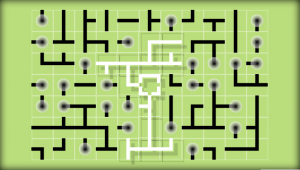In this article, I introduce another puzzle game, talk about some variations that are possible, provide a glossary (and then fail to use it, for now), discuss how the puzzle is solved, and then promise more in a future article. Before I get to that, however, I have included a tacked-on introductory paragraph that attempts to hold the article together, and hide the fact that there isn’t a clear thread running through it. That paragraph starts off bravely, but wavers and then fails at the end, degenerating into pathetic self-reference.
Introducing The Circuit Game
The Circuit Game is an on-line puzzle game where the aim is to connect all of the light bulbs to a power supply.
The bulbs and the power supply appear inside squares on a rectangular grid. Each square contains between one to four line segments representing wires, radiation from the centre to the four main compas points. Each square can be rotated in 90 degree increments. The idea is that by rotating each of the squares, it is possible to have all of the wires in adjacent squares connect up to form a “circuit” with each of the bulbs.
Here’s a screenshot example from Flashrolls.
There are many other implementations. For example, you can play at Mindjolt, where it is called ConfuseBox.
For a variation, based on pipes instead of power, try Rotate2. Rotate is another version, based on photographs, but that’s out of the scope of this article.
Variations
There are a number of variations of the game. Here I list some that I have found, and some that I have conjectured could exist.
Walls
I originally played a variation of this game (which I haven’t bothered to try to find again) which included barrier walls between some parts of the circuit, which could not be crossed by wires.
Flashrolls’ version of the game adds walls during the game as a form of hint, if requested.
Flag Cells
The original version I played allowed you to mark cells with a flag. That allowed you to note which cells were solved and should remain fixed, and which you still needed to concentrate on. This made solving the larger puzzles much less cumbersome.
Permit Cycles?
Rotate2 permits cycles in the graphs.
For the other implementations, I haven’t noticed any game rules that explicitly forbid cycles in the path. I also haven’t noticed any solutions that have cycles in them.
Power Cells
Most versions have a concept of a power cell. They light up the wires and bulbs that are connected to the power cell, and not the ones that are disjoint from it.
These versions of the puzzle do not permit disjoint solutions; every node in the graph must be connected (indirectly) to every other. Adding a Power Cell provides a simple visual reminder of that. When considered that way, it becomes clear that the Power Cell is no different to any other cell; any one of them could be marked as the power-cell, and it would have the same solution.
If you don’t have Power Cells, you need to decide if disjoint graphs (with no half-connected edges) are a valid solution. Rotate2 permits disjoint solutions.
Cross Cells
Some versions include a cross cell (with wires that point in all four directions). Such a cell never needs to be rotated, as it is rotationally symmetric.
Empty Cells
Some versions permit cells that have no wire in it. Like a Cross cell, it need not be rotated.
Distinct Wires
I have not seen this variation, but there is no reason why there couldn’t be two distinct (and disconnected) wires in a single cell. Such a solution could form cross-over or double-corner pieces, rather than a simple cross cell.
Wildcard Cells
I have not seen this variation either, but notionally, you could have a cell that morphs to accept any connections that attach to it.
Hexagonal Cells
I haven’t seen this, I’m just saying, it’d be cool. That’s all.
Taxonomy
This table describes all the types of pieces, to act as a glossary, for later.
| Name | No. of Wires | No. of Orientations | Notes |
|---|---|---|---|
| Empty | 0 | 1 | Does not appear in all implementations. |
| Bulb | 1 | 4 | Doesn’t actually have any special meaning. Merely a “dead-end” piece. |
| Corner | 2 | 4 | |
| Straight | 2 | 2 | |
| Tee | 3 | 4 | |
| Cross | 4 | 1 | Does not appear in all implementations. |
Manually Solving the Puzzle
Generally, they are solved from the outside in, with Straight and Tee pieces having only one permissible orientation along the outside edges.
From there, it is generally pieces that are wedged in a corner that are solved next.
I find it interesting that, while this puzzle seems to have a similar lever of complexity to similar looking games, such as Slitherlink, in practice the solutions seem to be much simpler to derive. I wonder if that is because the rules don’t permit the same level of complexity, or if it is merely that the instances of the puzzles I have seen don’t require it.
Coming Soon
Yet another automated solution…

Comment by Julian on January 18, 2009
A coveted OddThinking “Nice One!” award is winging its way to the makers of Grid.
It is another variant on the Circuit Game puzzle, but with a very interesting twist. They have power cells and permit cycles (neither of which is novel) but only cells currently connected up to the power cell are able to be turned.
This makes the sequence of the rotations relevant, and often requires you to rotate pieces into “incorrect” states, in order to reach subgoals of getting power to other unsolved pieces.
It’s a simple variant that adds another layer of interest to the game. Nice one!